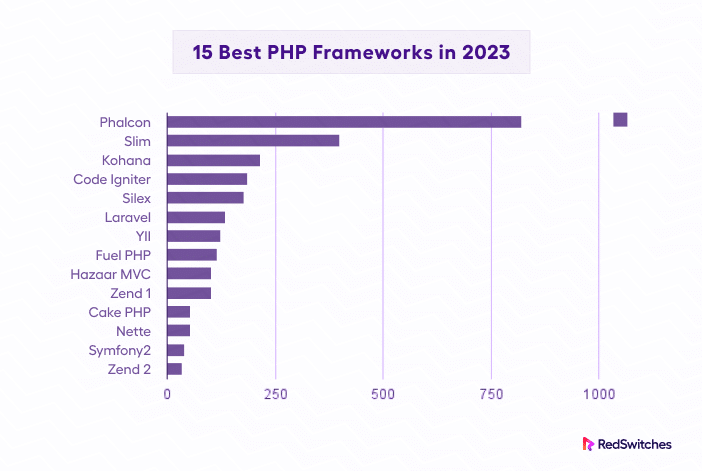In the vast world of web development, the importance of PHP remains undeniable. A robust and versatile server-side scripting language, PHP powers 77.5% of all websites where the server-side language is known.
Given its widespread adoption and versatility, the proliferation of PHP frameworks has been a boon for novice and seasoned developers. These frameworks simplify complex coding tasks and ensure the development of scalable, maintainable, and secure applications. With each passing year, there’s a surge in PHP frameworks, each with unique capabilities and tools designed to assist in building high-quality web applications.
As we dive into 2024, let’s explore the top 15 PHP frameworks that stand out, catering to both beginners aiming to grasp the core concepts and pros looking to elevate their coding prowess.
Table of Contents
- What is a PHP Framework?
- Core Components of a PHP Framework:
- Why use a PHP framework?
- 15 Best PHP Frameworks in 2024
- Choosing the Best PHP Framework
- Conclusion
- FAQs
What is a PHP Framework?
At its core, PHP, or ‘Hypertext Preprocessor,’ is a server-side scripting language majorly used for web development. But while PHP can stand alone as a raw language, it often requires considerable effort, extensive coding, and a deep understanding of best practices to create robust, secure, and efficient web applications from scratch. This is where PHP frameworks come into the picture.
Definition
A PHP framework is a platform that gives a structured, efficient, and reusable set of code libraries for everyday tasks in web development. These frameworks operate on the principle of Model-View-Controller (MVC) architecture, which segregates the application logic (Model), the user interface (View), and user inputs (Controller) into separate sections. This separation makes the code more organized and promotes modular development, allowing for easier testing, maintenance, and scalability.
Core Components of a PHP Framework:
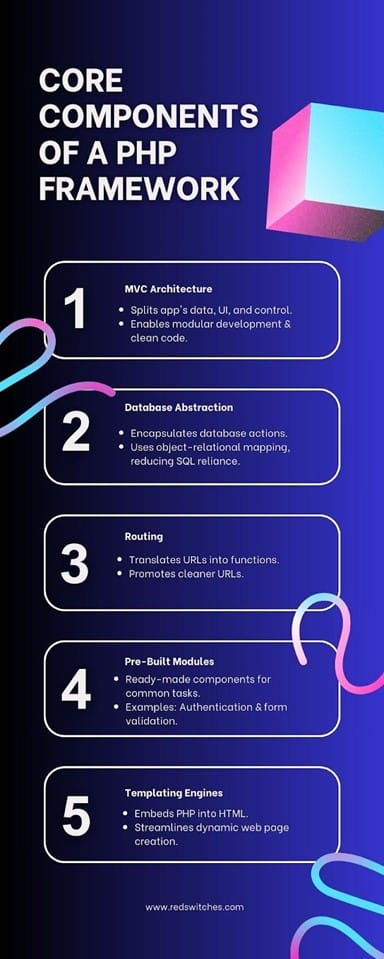
Model-View-Controller (MVC) Architecture:
One of the defining characteristics of a PHP framework is the adherence to the MVC paradigm. This architectural pattern partitions application data (Model), user interface (View), and the control flow (Controller) into distinct segments. This clear delineation encourages modular development, fosters clean code practices, and facilitates easier debugging.
Database Abstraction:
A PHP framework often encapsulates the intricacies of database interactions. Developers can harness object-relational mapping (ORM) or similar tools provided by the framework to manage databases using an object-oriented approach, reducing the reliance on SQL queries.
Routing Mechanisms:
Frameworks introduce sophisticated routing mechanisms, translating URLs into actionable functions. This promotes cleaner URLs and a more intuitive user experience.
Pre-Built Modules:
A PHP framework comes with pre-constructed modules from authentication systems to form validation. These modules alleviate the need for building standard functionalities from the ground up, ensuring both speed and consistency in development.
Templating Engines:
Many frameworks offer templating engines that allow developers to embed PHP code directly into HTML, streamlining the process of creating dynamic web pages.
A PHP framework is pivotal in modern web development, ensuring developers can construct high-quality applications with optimized performance and security measures.
They encapsulate best practices, provide reusable components, and offer a streamlined approach to solving complex problems.
Unlock the Full Potential of Your PHP Framework! Experience unmatched speed and performance with our Powerful Bare Metal Server Hosting Solutions.
Why use a PHP framework?
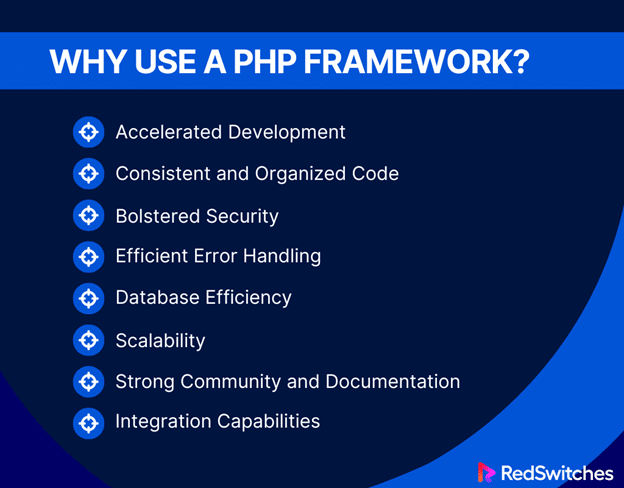
In the intricate tapestry of web development, every stitch and weave matters, determining web applications’ final quality and robustness. PHP framework has long been a favored thread in this tapestry, but its potency is amplified when combined with a framework. So, why should developers embrace the PHP framework in its toolkit?
Accelerated Development:
A PHP framework is pre-packed with numerous tools and libraries that streamline routine tasks. By leveraging these built-in resources, developers can reduce the amount of repetitive code, enabling them to bring applications to life more swiftly.
Consistent and Organized Code:
Frameworks encourage a consistent approach to coding, offering standard conventions and methodologies. This ensures uniformity across projects and makes it easier for other developers to understand and collaborate on a given project.
Bolstered Security:
One of the primary mandates of a renowned PHP framework is to fortify web applications against prevalent cyber threats. Features such as input filtering, output escaping, and protection mechanisms against SQL injections and CSRF attacks come built-in, providing a robust defense line.
Efficient Error Handling:
Frameworks offer sophisticated error-handling modules. These tools catch and manage errors during development, ensuring a smoother user experience in the final product and aiding developers in pinpointing and rectifying issues.
Database Efficiency:
Frameworks bring about a higher level of abstraction for database interactions. With features like ORM, developers can execute complex database operations without writing verbose SQL queries, ensuring accuracy and efficiency.
Scalability:
Constructed on sound architectural principles like MVC, a PHP framework is inherently modular, making it simpler to extend and scale applications in response to growing user demands or changing business requirements.
Strong Community and Documentation:
Active and dedicated communities back the best PHP frameworks. This ensures continuous updates, extensive documentation, and a wealth of resources and tutorials – invaluable assets for novice and seasoned developers.
Integration Capabilities:
A PHP framework often supports seamless integration with third-party applications and tools, be it payment gateways, email services, or analytics tools, enabling developers to create feature-rich applications without starting from scratch.
In the dynamic world of web development, a PHP framework emerges as the pillar of efficiency, security, and scalability. They encapsulate decades of collective wisdom, best practices, and innovation, enabling developers to craft superior web applications precisely and confidently.
Confused between PHP and Python for your next project? Dive into our comparative guide on Python vs PHP and make an informed decision!
15 Best PHP Frameworks in 2024
As we delve deeper into the digital age, the tools we utilize for web development have become increasingly crucial. PHP, a cornerstone of web programming, continues to evolve, with it, the frameworks that streamline and amplify its capabilities.
As 2024 unfolds, many PHP frameworks are vying for the attention of developers, each offering unique features, optimizations, and innovations. The choices are diverse and compelling, from frameworks tailored for beginners taking their first steps into the world of web development to sophisticated platforms designed for seasoned pros handling complex projects.
In this section, we journey through the crème de la crème, presenting the top 15 PHP frameworks 2024 that have risen above the fray, setting benchmarks in functionality, efficiency, and user experience.
1. Laravel
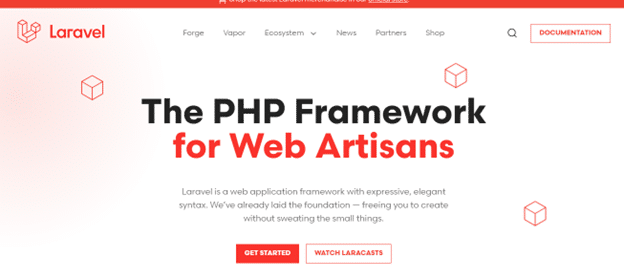
Credit: Laravel
Taylor Otwell introduced Laravel in 2011, and in the short span since its inception, it has earned its place as one of the most revered frameworks for web application development. The secret behind its rapid ascent? A unique fusion of intuitive structure and a sophisticated toolkit that equips developers with everything needed to craft stellar web applications.
Laravel’s hallmark is undeniably its elegant syntax. Designed to be functional and expressive, this syntax ensures developers can churn out efficient solutions while maintaining clean, readable code. This clarity is a boon for collaborative projects, ensuring that teams can work seamlessly, understanding and building upon each other’s work easily.
Why Use Laravel?
Peeling back the layers of Laravel’s appeal, one finds compelling reasons that justify its widespread adoption. With Laravel, rapid application development becomes the norm, security is fortified at its foundation, and an active, passionate community is its backbone.
- Rapid Development: At its core, Laravel is about efficiency. A suite of ready-to-use tools and features accelerates the development timeline, ensuring quality isn’t sacrificed for speed.
- Security: In an era where cyber threats loom, Laravel is a fortress. It’s not just secure; it’s a proactive framework for its defenses, guarding against potential vulnerabilities.
- Active Community: Beyond its technical prowess, Laravel’s community is its lifeblood. This bustling network ensures a constant flow of updates, plugins, and collective wisdom, making development smoother and more collaborative.
Advantages & Disadvantages of Laravel
Navigating the pros and cons of Laravel offers a holistic view, enabling informed decisions. While Laravel is undoubtedly feature-rich and developer-friendly, it’s also essential to acknowledge areas where it might have limitations.
Advantages:
- Efficient Coding: At the heart of Laravel is a drive for streamlined coding. Its comprehensive library minimizes redundancy, ushering in smoother development cycles.
- Scalability: Regardless of scale, Laravel is adept. It’s built to adapt, ensuring it meets the demands of both small and expansive applications.
- In-built Security: Security isn’t an afterthought with Laravel. With its robust access control mechanisms, Laravel is the first line of defense against threats.
- Comprehensive Features: Laravel’s features encompass a broad spectrum, from authentication to task management, making it a one-stop solution for diverse web development needs.
Disadvantages:
- Cost Implications: Laravel’s surge in popularity has an economic side effect: seasoned Laravel developers can command premium rates.
- Support Dynamics: Given its relative youth compared to other stalwarts, Laravel may sometimes lack the extensive support system older frameworks boast.
- Update Cadence: To stay at its best, Laravel demands regular updates, which might be a consideration for long-term maintenance.
- Performance Metrics: Feature richness sometimes comes at a cost. Due to its extensive functionalities, Laravel can occasionally lag in speed compared to more lightweight frameworks.
Concluding, Laravel, with its myriad advantages, is undeniably a formidable framework. However, the key lies in aligning its features with project-specific needs and future goals. This alignment ensures optimal utilization of Laravel’s prowess while being aware of its limitations.
Utilizing PHP framework? Enhance your database management skills by learning how to install phpMyAdmin on Ubuntu. Follow our step-by-step guide!
Also Read: Laravel vs Angular: Decoding the Web Development Duel
2. Symfony
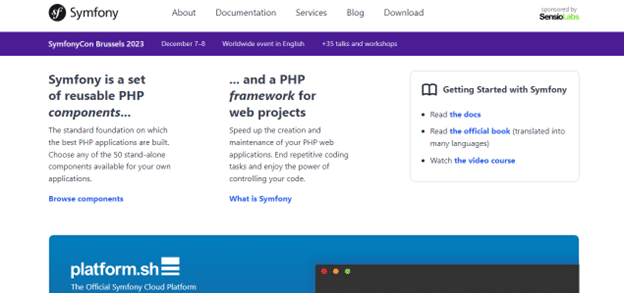
Credit: Symfony
Symfony stands tall amidst many web development tools, securing its place in the best php framework lists. With its capability to build robust web applications, APIs, and more, it’s no surprise that Symfony is a favorite amongst seasoned developers.
Understanding the core of Symfony, we encounter a framework that is a harmonious blend of flexibility and efficiency. It isn’t merely a framework but an ensemble of 50 standalone components designed meticulously to serve specific web application needs. Its robust performance metrics further exemplify Symfony’s prowess, making it a perfect choice for web development projects demanding speed and precision.
Stepping into the world of learning resources Symfony offers, the framework ensures developers are never in the dark. The rich arsenal, from a detailed video course to an official book, is aimed at nurturing proficiency in Symfony. Complementing these is comprehensive documentation made accessible to a global audience with translations in numerous languages.
Why Use Symfony?
Pondering the reasons behind Symfony’s appeal, it becomes clear that this framework isn’t just about coding but enabling. Symfony is a solution tailored for those seeking performance without compromising on the flexibility of component choices.
- High Performance: Symfony isn’t just another player; it’s an industry leader in speed and efficiency in creating PHP web applications.
- Component Flexibility: The framework’s architecture embodies versatility. Developers are empowered with the luxury of picking from 50 standalone components, ensuring a tailored solution for every project.
- Unwavering Community Support: Beyond the technical brilliance, Symfony is backed by a formidable community. This ensures the framework is continually evolving, staying abreast of industry standards.
Advantages & Disadvantages of Symfony
To truly grasp the scope of Symfony, it’s crucial to weigh its merits against its limitations. While Symfony is packed with features and capabilities, understanding its challenges ensures developers can navigate potential pitfalls.
Advantages:
- Peak Performance: Symfony stands out for its remarkable performance, ensuring applications built are swift and efficient.
- Architectural Flexibility: The heart of Symfony lies in its modular architecture. With 50 components on offer, solutions can be custom-crafted with precision.
- Community Strength: A thriving community encircles Symfony, promising regular updates and collective problem-solving capabilities.
- Holistic Learning Resources: Developers are never left stranded, thanks to Symfony’s extensive educational tools, ranging from video courses to translated documentation.
Disadvantages:
- Steep Learning Curve: Mastery over Symfony demands dedication. Compared to some of its counterparts, Symfony can be challenging to grasp initially.
- Limited Developer Pool: The Symfony developer community, while strong, isn’t as expansive as some other popular frameworks. This could sometimes translate to higher costs for hiring experts.
- Feature Absence: While robust, Symfony isn’t without its shortcomings. It could benefit from additional features to enhance its appeal further in some areas.
In summation, Symfony is a robust contender in the PHP framework realm. While it boasts many benefits, aligning its strengths with project requirements ensures the best utilization of what Symfony offers while being vigilant of its few limitations.
Get a firm grasp of databases to enhance your PHP projects! Delve into our comprehensive introduction to databases and DBMS.
3. CodeIgniter
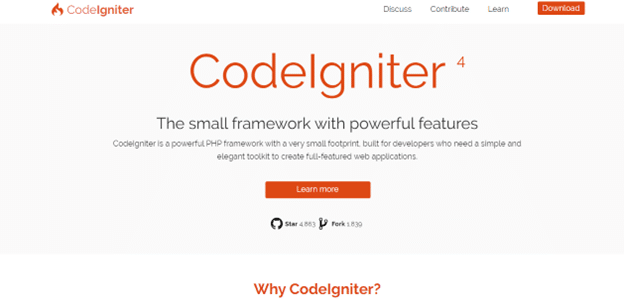
Credit: CodeIgniter
CodeIgniter confidently carves its niche as we traverse the realm of top PHP frameworks. With its dedication to offering a streamlined experience for web application development, it’s evident why it is revered amongst popular PHP frameworks.
CodeIgniter is not merely a tool but a symphony of simplicity and functionality. The framework’s distinction lies in its compact nature, ensuring developers benefit from a lightweight yet feature-rich environment. The framework’s commitment to flexibility is evident, promoting but not imposing the Model-View-Controller (MVC) architecture.
A step ahead in cybersecurity, CodeIgniter champions robust protection mechanisms, including defenses against Cross-Site Request Forgery (CSRF) and Cross-Site Scripting (XSS) attacks. The commitment to progress is palpable with its latest version designed for PHP 7.4+, encompassing modern features like context-sensitive escaping and a Content Security Policy (CSP).
Why Use CodeIgniter?
CodeIgniter offers a mix of essential features and robust characteristics, making it an attractive choice for web developers. Here are some compelling reasons:
Performance:
Known for its exceptional speed and efficiency, CodeIgniter ensures web applications run smoothly and quickly.
Lightweight:
Thanks to its small footprint, it’s agile and easy to integrate, making the development process more streamlined.
Robust Security:
Integrated mechanisms against common web threats, including CSRF and XSS attacks, offer a safer web application environment.
Flexibility:
While promoting the MVC paradigm, CodeIgniter allows developers to use it as they see fit, without enforcing strict standards.
Simplicity:
The straightforward and sophisticated toolkit is designed for easy use, making it especially friendly for beginners.
Active Community:
While it may be smaller than some competitors, the CodeIgniter community is active and supportive, making finding solutions and discussing best practices easier.
Documentation:
Comprehensive and well-organized documentation aids developers at all skill levels, ensuring that they can make the most out of the framework’s features.
Advantages & Disadvantages of CodeIgniter
Like any tool, CodeIgniter shines in many aspects but has areas where competitors might outpace it.
Advantages:
- Efficient and Light: Known for its compact nature, CodeIgniter ensures swiftness and optimal performance.
- Robust Security: With defenses against CSRF and XSS attacks, it prioritizes user and application security.
- Flexibility: While it leans towards MVC, CodeIgniter offers developers the freedom to diverge.
- Simplicity: The framework’s toolkit is intuitive, ensuring a smoother learning experience for beginners.
Disadvantages:
- Smaller Community: Compared to giants like Laravel or Symfony, CodeIgniter has a more compact community.
- Feature Constraints: While it’s rich in functionalities, some might find it less feature-packed than other top PHP frameworks.
To wrap up, CodeIgniter remains a formidable contender in the popular PHP framework list. Its approach towards web application development ensures that it remains a popular choice for many. However, matching the framework’s capabilities with project requirements is essential for optimal outcomes.
4. CakePHP
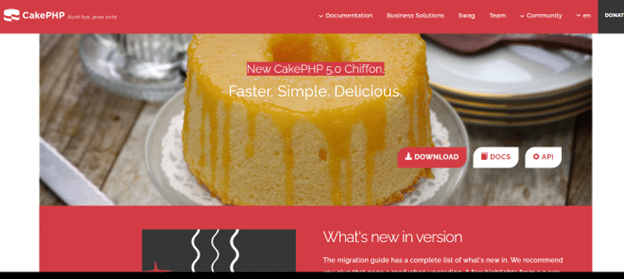
Credit: CakePHP
CakePHP stands out in the extensive list of top PHP frameworks and is an optimal choice for many web developers. As an open-source PHP framework, CakePHP offers a convenient, refined toolkit to craft comprehensive web applications. The inherent nature of CakePHP, characterized by its diminutive footprint, ensures it remains both lightweight and user-friendly.
By promoting the Model-View-Controller (MVC) design pattern, CakePHP assists developers in maintaining a clear distinction between application logic and presentation, ensuring organized and maintainable code structures.
Why Use CakePHP?
Delving deeper into CakePHP, several distinct advantages make it a popular choice among developers:
User-centric Development:
Embracing the MVC architecture, CakePHP is inherently user-friendly, enabling efficient and rapid coding processes.
Security Measures:
CakePHP comes equipped with inbuilt tools tailored for security, caching, and validation, facilitating a more secure and optimized application development environment.
Database Interactions:
CakePHP stands out with its capability to effortlessly manage database operations, be it insertion, updating, or deletion tasks, granting developers seamless control over database functions.
Unit Testing Support:
With its built-in unit testing framework, CakePHP paves the way for developers to conduct comprehensive application tests, ensuring the software’s reliability and robustness.
Broad Compatibility:
CakePHP boasts impressive compatibility with stable PHP versions, ensuring that applications remain future-proof and adaptable.
Advantages and Disadvantages of CakePHP
CakePHP, one of the popular PHP frameworks, has been chosen by developers worldwide for its unique features. But like all software tools, it comes with both advantages and disadvantages:
Advantages:
- Rapid Development: With CakePHP’s conventions, developers can quickly scaffold and generate code, speeding up the development process.
- Security: The framework offers robust security features, including SQL injection prevention, CSRF protection, and input validation, which bolster the security of web applications.
- MVC Pattern: By enforcing the Model-View-Controller architectural pattern, CakePHP aids in separating business logic from data and presentation layers, ensuring cleaner and more maintainable code.
- Active Community: CakePHP has a supportive community, which ensures timely updates, bug fixes, and an extensive pool of resources for new developers.
- Zero Configuration: CakePHP requires little configuration, making the setup process hassle-free.
- Built-in ORM: CakePHP’s built-in Object-Relational Mapping (ORM) provides an easy-to-use interface to interact with databases, making data operations more intuitive.
- Licensing: Being open-source and distributed under the MIT license, CakePHP is free for everyone, making it an affordable choice for startups and independent developers.
Disadvantages:
- Learning Curve: For beginners transitioning from raw PHP or other frameworks, there can be an initial learning curve to understand CakePHP’s conventions and structure.
- Performance Overhead: As with most full-stack frameworks, CakePHP might introduce some performance overhead compared to micro-frameworks or raw PHP.
- Documentation: While CakePHP has extensive documentation, some developers feel that it isn’t as comprehensive or user-friendly as possible.
- Plugin Dependency: For extended features, developers might need plugins. Finding a well-maintained or suitable plugin can sometimes be a challenge.
- Less Modern: With newer frameworks like Laravel introducing modern PHP practices and features, some developers feel CakePHP is somewhat dated, although this is subjective.
In conclusion, CakePHP offers balanced features for rapid web application development. While it shines in many areas, developers should know its limitations before diving in.
5. Yii
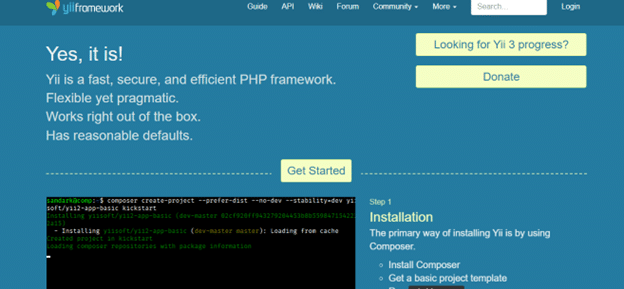
Credit: Yii
Yii, pronounced “Yee,” is a high-performance PHP framework for web application development. As one of the popular PHP frameworks, Yii is open-source and provides developers with a streamlined toolkit for crafting feature-rich applications. The Model-View-Controller (MVC) architecture that it adopts ensures a separation of logic from presentation, enabling more organized coding practices.
Why Use Yii Framework?
Choosing a framework for web application development is essential as it lays the foundation for the entire project. Among the many PHP frameworks available, Yii distinguishes itself for a range of compelling reasons:
Performance Excellence:
Yii is renowned for its swift execution, which directly contributes to the optimal performance of web applications built on it. This speed ensures web applications are responsive and can handle many requests efficiently.
Robust Security Measures:
Yii provides in-built tools to address and prevent common web attacks. Whether it’s Cross-Site Request Forgery (CSRF) or Cross-Site Scripting (XSS) attacks, Yii has protective mechanisms to enhance the security of applications.
Architectural Flexibility:
Yii is grounded in the MVC architectural pattern, promoting clean, organized, and reusable code. Yet, it doesn’t impose this architecture rigidly. Developers can employ different architectural patterns if they deem fit for their project.
Developer-Friendly:
The framework is designed with developers in mind. Yii’s toolkit is efficient and intuitive, making the learning curve more gentle, especially for those new to the framework.
High Compatibility:
Yii’s design ensures seamless compatibility with the latest stable versions of PHP. This forward compatibility means that applications built on Yii are less likely to face issues with newer PHP versions.
Extensive Extensions:
Yii’s vast extension library allows developers to integrate various functionalities without building them from scratch. This accelerates the development process.
Advantages of Yii:
The following are the advantages of Yii:
- Fast Performance: Yii has been noted for its exceptional speed compared to other PHP frameworks.
- Built-in Security: The framework comes with tools that help guard against common web attacks such as CSRF and XSS.
- Flexibility: While Yii promotes using the MVC pattern, it doesn’t rigidly enforce it, offering developers flexibility.
- Ease of Learning: With its well-documented resources and intuitive toolkit, newcomers can quickly grasp Yii’s concepts.
- Compatibility: Yii maintains a high level of compatibility with the stable versions of PHP, ensuring consistent performance across environments.
Disadvantages of Yii:
The following are the disadvantages of Yii:
- Smaller Community: Yii, while popular, has a smaller community than giants like Laravel or Symfony. This can sometimes translate to fewer community-driven resources or extensions.
- Feature Set: While Yii is feature-rich, it might lack certain out-of-the-box functionalities that some larger frameworks offer.
Ever wondered how PHP frameworks fare in cloud computing or web-based apps? Understand the dynamics with our in-depth article!
6. Zend
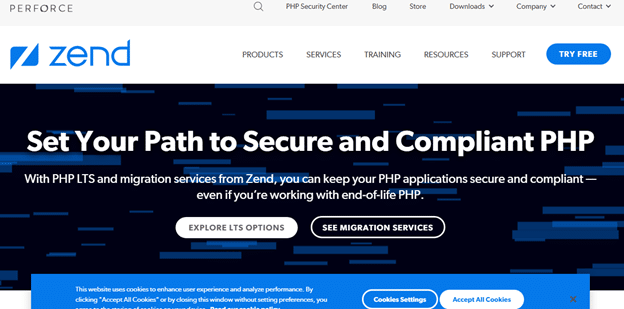
Credit: Zend
Zend is a renowned PHP development platform and service provider. It offers various services, including long-term support, migration services for PHP applications, and expert guidance for PHP projects.
This encompasses tasks such as migrations, performance audits, and consultative support. Zend provides enterprise support for Zend Framework and Laminas, ensuring ongoing security patches and expert consultative assistance. Those exploring PHP runtimes can turn to ZendPHP, a certified and supported solution catering to numerous platforms and distributions. This platform boasts over 50 supported PHP extensions.
For individuals seeking a comprehensive experience, Zend Server offers a 30-day free trial. If your enterprise requires PHP LTS or other specific PHP services, Zend’s experts always guide you.
Why Use Zend?
In the vast realm of PHP development platforms, Zend stands out for several reasons:
- Comprehensive Support: Beyond the development platform, Zend offers a holistic support system with migration services, performance checks, and expert guidance.
- Enterprise-Ready: Zend is equipped to handle enterprise requirements, providing ongoing security patches and support for its frameworks.
- Versatile Runtimes: With Zend PHP, developers can access PHP runtimes tailored to varied platforms, ensuring compatibility and extended functionality.
Advantages and Disadvantages of Using Zend
When considering Zend as your go-to PHP development platform, it’s essential to understand its strengths and limitations to gauge if it aligns with your project’s requirements.
Advantages:
- Customization: Zend provides many features, allowing developers to craft bespoke web applications as per their needs.
- Enterprise-Level Applications: Given its robust framework, Zend is the preferred choice for large-scale, enterprise-level applications. It is equipped to handle extensive databases efficiently.
- HTML5 Compliant: Zend facilitates front-end development in HTML5, supporting various input data types and ensuring client-side field validation.
- Object-Oriented Programming (OOP): Zend fully embraces the principles of OOP, like inheritance and reusability, streamlining the web development process.
- Vibrant Community: Zend’s long-standing reputation means a vast community of seasoned developers willing to share their expertise and resolve queries.
Disadvantages:
- Entry Cost: Owing to its vast feature set, the initial cost of using Zend can be high.
- Size and Speed: Zend’s extensive framework might feel bloated to some users, and its operational speed may be perceived as slower. Consequently, it might not be the first choice for smaller projects.
7. Phalcon
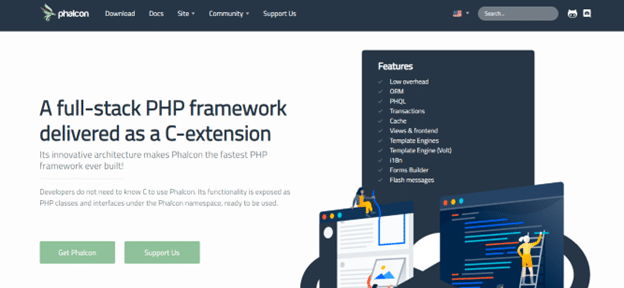
Credit: Phalcon
Phalcon is a distinct PHP web framework based on the model-view-controller (MVC) pattern. Unique to PHP frameworks, Phalcon stands out as it’s implemented as a web server extension. It’s not written in PHP like most counterparts but in Zephir and C.
This innovative approach aims to supercharge the execution speed, drastically reduce resource consumption, and accommodate more HTTP requests per second in comparison to other frameworks that predominantly use PHP. It’s a testament to Phalcon’s groundbreaking architecture that it has earned the title of the fastest PHP framework.
For developers wondering about the intricacies of C, there’s good news! There’s no need for an in-depth understanding of C to utilize Phalcon. Its functions manifest as PHP classes and interfaces under the Phalcon namespace, prepped and primed for use. For those eager to delve deeper or get started, the official Phalcon website is a comprehensive resource.
Why Use Phalcon?
The decision to opt for a specific framework often revolves around its unique offerings. Phalcon provides
Performance:
Given its Zephir and C base, Phalcon dramatically outperforms most PHP-based frameworks in speed and efficiency.
Resource Efficiency:
Phalcon is renowned for its minimal resource usage, ensuring that applications remain lightweight and responsive.
Developer-Friendly:
Despite its C underpinnings, Phalcon is crafted to be user-friendly for PHP developers, requiring no C knowledge.
Advantages and Disadvantages of Phalcon
In the software realm, every tool and framework comes with its set of advantages and potential pitfalls. Recognizing these can aid in making an informed choice.
Advantages:
- Speed: One of Phalcon’s most significant selling points is its blazing fast speed, resulting from its unique implementation as a web server extension.
- Low Overhead: Phalcon uses fewer resources, ensuring that applications remain agile.
- Flexibility: Developers can build performance-optimized applications without delving into C, thanks to Phalcon’s PHP class exposure.
- Security: Phalcon has robust security features built-in, such as CSRF and XSS protection.
Disadvantages:
- Learning Curve: While PHP-centric, the unique architecture might present a learning curve for some developers.
- Hosting Restrictions: Given that Phalcon is a C-extension, some shared hosting platforms might not support it.
- Community Size: Compared to other well-known PHP frameworks, Phalcon has a relatively minor community, which could affect the availability of tutorials, plugins, and third-party resources.
The right hosting can make a massive difference in your PHP framework-based projects. Explore the types of web hosting services with our thorough guide!
8. FuelPHP
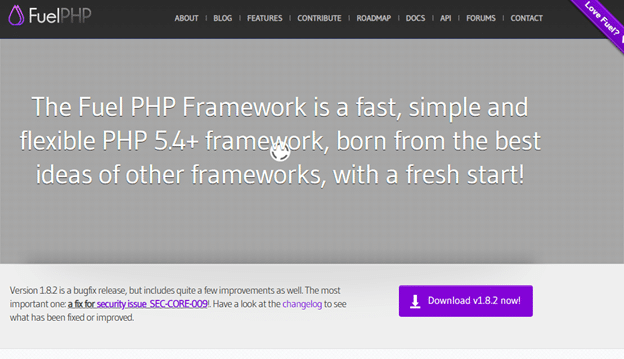
Credit: FuelPHP
FuelPHP is a flexible PHP web application framework that caters to a broad audience, from beginners to PHP veterans. Its characteristic appeal lies in its simplicity, ensuring a smooth learning curve for newcomers to PHP frameworks.
But don’t let its simplicity deceive you; it’s a full-stack framework, packing many features ranging from ORM (Object-Relational Mapping) and caching to validation. A noteworthy architectural feature of FuelPHP is its use of the Hierarchical Model-View-Controller (HMVC) pattern. This innovative approach to web development allows for creation of modular and highly reusable code.
Why Use FuelPHP?
When considering a web development framework, several factors come into play. FuelPHP offers
- Flexibility: Tailored to meet varied needs, developers can handpick components to integrate into their projects.
- User-Friendliness: With an emphasis on ease of use, beginners to PHP frameworks find FuelPHP’s learning curve relatively smooth.
- Full-stack Features: Beyond its easy-to-use facade, FuelPHP has features offering functionalities like ORM, caching, and validation.
- HMVC Support: By implementing the HMVC pattern, FuelPHP ensures developers can weave modular and reusable codes into their projects.
Advantages and Disadvantages of Using FuelPHP
Every framework presents its own set of strengths and potential limitations. Recognizing these can be instrumental in making an informed choice.
Advantages:
- Flexibility: Its design allows developers to select and utilize desired components.
- Beginner-friendly: Designed with usability, it welcomes newcomers to PHP frameworks.
- Comprehensive Features: A full-stack framework, it’s equipped with functionalities like ORM, caching, and validation.
- HMVC Pattern: FuelPHP’s commitment to HMVC ensures that modular and reusable code becomes a standard practice.
Disadvantages:
- Smaller Community: When juxtaposed against titans like Laravel or Symfony, FuelPHP’s community appears smaller.
- Documentation Concerns: Comprehensive documentation aids in smooth development, but FuelPHP lags in this department compared to its peers.
- Support Issues: A smaller community might encounter occasional challenges in obtaining support or solutions to specific problems.
9. Slim
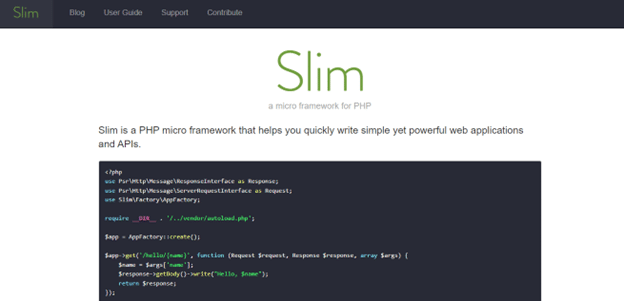
Credit: Slim
Slim is a distinctive PHP micro-framework that places emphasis on simplicity and ease of use. Created to serve developers who require a nimble solution, Slim stands as a beacon for those wanting to craft small-scale web applications or APIs without the overhead of full-stack frameworks.
Its architecture revolves around the middleware concept, empowering developers to modularly append functionality to their applications. Middleware, in the Slim context, is essentially a bridge or layer that allows developers to execute code before and after the main application, offering flexibility and modular capabilities.
Why to Use Slim?
Slim stands out as a minimalistic yet powerful PHP framework designed explicitly for creating APIs. Its core appeal lies in its simplicity and efficiency.
Performance & Efficiency:
Slim prides itself on being lean. At its core, it functions as a routing library, deftly managing HTTP requests and responses. Its efficiency means rapid response times and lower resource overhead.
Full Control & Flexibility:
Slim is not an “all-in-one” solution. Instead, it allows developers to extend its core functionalities through middleware. This ensures you only add what you need, reducing bloat and maintaining speed.
Standards Compliant:
Adopting industry standards like PSR-7 and PSR-15, Slim avoids vendor lock-in, enabling developers to interchange parts of their stack as needed.
Ease of Learning:
Without the extensive features that full-stack frameworks possess, Slim offers a more gradual learning curve, making it especially beneficial for those new to PHP frameworks.
Modern Web App Development:
Slim shines in developing modern RESTful APIs and services, easily integrating with frontend frameworks like React or Vue.
Advantages and Disadvantages:
Navigating the world of frameworks requires a balanced understanding of their strengths and limitations. Let’s delve into the advantages and disadvantages of Slim to provide a comprehensive perspective on its utility and potential challenges.
Advantages
- Middleware Centric: Slim employs the middleware concept, enabling developers to modularly augment the framework’s functionalities. This makes building complex applications seamless, with available middleware ranging from authentication to caching.
- Open Source & Community Driven: With its roots in the open-source world, Slim benefits from collaborative development, ensuring continuous updates and many third-party integrations.
- Performance: Historically, Slim has ranked admirably in performance benchmarks, often outperforming other micro-frameworks.
- Extensibility: While Slim might be minimal at its heart, it can be seamlessly extended using third-party middleware or even developed into an MVC framework using tools like Twig-View for server-side rendering.
Disadvantages
- Limited Out-of-the-Box Features: Given its micro-framework designation, Slim might require manual integration for functionalities bundled with full-stack frameworks.
- Dependency on Middleware: While middleware offers flexibility, it can also be a double-edged sword. Reliability might vary across third-party middleware, and ensuring compatibility can sometimes be challenging.
- Smaller Community: While Slim boasts a dedicated community, it’s smaller than giants like Laravel. This might occasionally make troubleshooting or finding specific plugins more challenging.
Slim offers a harmonious blend of performance, flexibility, and simplicity, making it a potent choice for many web projects, especially those centered around APIs.
Facing ‘502 Bad Gateway’ while working on your PHP frameworks? Unravel its meaning and discover 8 solutions to tackle it!
10. Fat-Free Framework
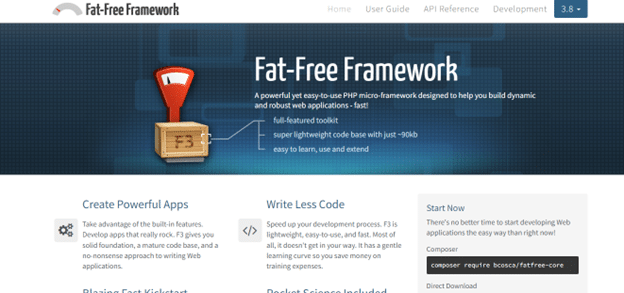
Credit: Fat-Free Framework
Fat-Free Framework, commonly called F3, stands out as a PHP micro-framework tailored to empower developers to craft dynamic and robust web applications with relative ease. Built upon a concise code base of approximately 90kb, it offers a feature-packed toolkit without the complexities or bloat often associated with larger frameworks. The essence of Fat-Free Framework lies in its streamlined functionality combined with a mature codebase, enabling developers to produce web applications that are both efficient and effective.
Navigating the comprehensive realm of web frameworks often boils down to understanding their unique offerings and potential pitfalls. The subsequent sections will provide insights into why one might choose the Fat-Free Framework and a balanced evaluation of its advantages and disadvantages.
Why Use Fat-Free Framework?
Lightweight Core:
At just around 90kb, Fat-Free boasts a minimalistic footprint, optimizing performance and load times.
Comprehensive Feature Set:
Out-of-the-box support for SQL and NoSQL databases, catering to diverse data management needs.
Extensible Plugins:
A wide range of plugins, from template engines to unit testing toolkits, enhance its capabilities without bloating the core.
Flexibility & Modularity:
It offers a customizable environment, allowing developers to tailor the framework to their requirements, and supports middleware for added adaptability.
Streamlined Development:
Known for its gentle learning curve, it is user-friendly for novices and experts.
Rapid Prototyping:
The framework’s structure and tools enable quick development and iteration of web applications.
Versatile Database Support:
Out-of-the-box support for databases like MySQL, SQLite, MSSQL/Sybase, PostgreSQL, MongoDB, and its Flat-File DB (Jig).
Diverse Plugin Ecosystem:
The framework boasts a rich set of plugins from Markdown-to-HTML converters to on-the-fly Javascript/CSS compressors.
Community Support:
Active communities on platforms like Google Group, Slack, or Matrix for peer assistance and knowledge sharing.
Advantages and Disadvantages
Every framework comes with its unique set of strengths and weaknesses. As we navigate through the landscape of the Fat-Free Framework, it’s crucial to gain a holistic view of its advantages and potential pitfalls. Let’s delve deeper to understand what this framework offers and where it might pose challenges.
Advantages
- Lightweight & Efficient: Fat-Free is incredibly lightweight with a mere 90kb code base, ensuring fast performance without compromising on features.
- Versatile Database Support: The framework supports a range of SQL and NoSQL databases, making it adaptable to various project requirements.
- Extensive Features: F3 offers many built-in functionalities, ranging from its swift template engine to a comprehensive unit testing toolkit, data validation, and more.
- Rapid Development: The no-nonsense approach of F3, combined with its gentle learning curve, ensures developers can swiftly move from conception to production.
- Flexible Extensibility: Through optional plugins, developers can extend the framework’s capabilities further, allowing for a custom-tailored development environment.
Disadvantages
- Not Ideal for Large-Scale Projects: F3 might not be the best choice for expansive projects requiring extensive team collaboration. More structured frameworks like Yii or Zend could be better suited for such endeavors.
- Smaller Community: Compared to well-known frameworks, F3 has a relatively minor community, which might translate to fewer resources, tutorials, and third-party extensions.
- Lack of Certain Advanced Features: While F3 is feature-rich, specific advanced or niche functionalities available in full-stack frameworks might be missing.
11. PHPixie
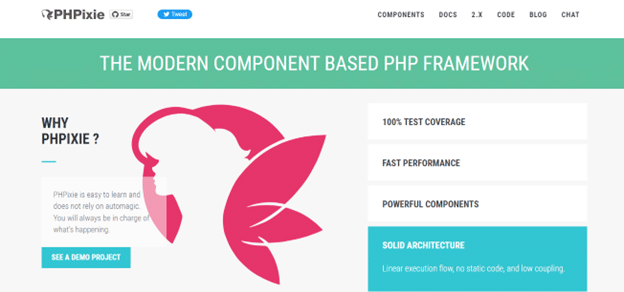
Credit: PHPixie
PHPixie is a PHP micro-framework meticulously designed to assist developers in crafting dynamic and robust web applications easily. It boasts a full-featured toolkit yet retains a remarkably lightweight code base, weighing approximately 1.5MB. This lightness ensures that PHPixie is not only user-friendly but also extendable.
Delving deeper, PHPixie is built upon a robust foundation and a seasoned code base, rendering it a reliable choice for web application development. PHPixie’s straightforward, no-nonsense approach significantly simplifies the app development process, ensuring that the resultant applications are efficient and robust.
Why Use PHPixie?
Choosing the right framework is crucial in setting the pace and quality of development. PHPixie stands out for various reasons:
Lightweight:
A code base of around 1.5MB ensures quick loads and efficient operations.
Speed:
PHPixie is architected for velocity, ensuring that applications are efficient and deliver high performance.
Versatile Database Support:
Whether you’re working with SQL or NoSQL, PHPixie has covered you. It supports various databases, including MySQL, PostgreSQL, and MongoDB.
Extensibility:
PHPixie is built to grow with your needs. With many plugins available, you can enhance its capabilities as your project evolves.
Advantages and Disadvantages of PHPixie:
To make an informed decision, one must weigh the strengths against the potential drawbacks. Here’s a deep dive into PHPixie’s advantages and challenges.
Advantages:
- Compact and Efficient: PHPixie’s tiny footprint ensures that it remains efficient and doesn’t hog resources.
- Feature-Rich: Despite its size, PHPixie doesn’t compromise on features. It boasts powerful ORMs, diverse database support, and more.
- Extensible: Its architecture is designed to seamlessly integrate with various plugins, enhancing its features per the project’s demands.
- Supportive Community: PHPixie boasts an active community, ensuring developers can always seek assistance or share insights.
Disadvantages:
- Popularity: In the vast sea of PHP frameworks, PHPixie isn’t as renowned as giants like Laravel or Symfony. This could mean a smaller community and fewer third-party resources.
- Not Ideal for Large-scale Projects: Developers might prefer frameworks with a stricter and more structured environment for monumental projects involving extensive teams.
Remember, the right tool always depends on the specific needs and nuances of the project. While PHPixie might be a perfect fit for many, evaluating its capabilities in the context of the project’s requirements is crucial.
12. Aura
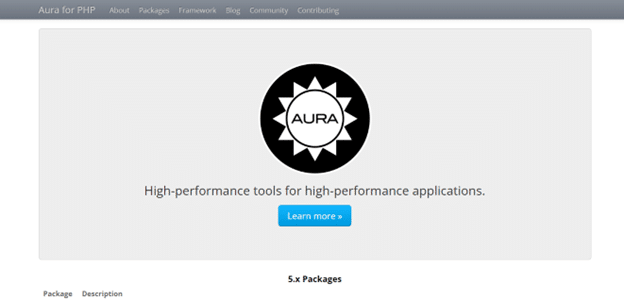
Credit: AuraPHP
Aura PHP stands out in the vast landscape of PHP tools as a distinguished collection of modular libraries tailor-made for developers striving to craft exceptional web applications. These libraries are underpinned by simplicity, versatility, and uniformity principles, ensuring each component is functionally robust and consistently designed.
From advanced dependency management with Aura.Di and the precision of Aura.Router in directing requests to the intuitive database interactions offered by Aura.Sql, Aura PHP encapsulates a philosophy where innovation meets elegance.
The framework emphasizes modularity, allowing developers to handpick only what they need, ensuring efficiency without unnecessary overhead. Yet, its strength doesn’t just lie in its individual components but in harmony with its collective, providing a comprehensive toolkit that’s both beginner-friendly and versatile enough for complex projects. Aura PHP doesn’t merely offer libraries; it offers a vision of streamlined and elevated web development.
Why Use Aura PHP?
Every tool, every library, and every framework brings something unique to the table. For Aura PHP, it’s the following:
Modularity at its Finest:
Only pull in what you require. Aura PHP’s modular design ensures you aren’t bogged down by unnecessary bulk.
Beginner-friendly:
Despite its robust offerings, Aura PHP ensures newcomers’ learning curve remains gentle.
Uniformity and Consistency:
A consistent coding style across libraries makes development smoother and more intuitive.
Reuse, Redefine, Recreate:
Given their versatile design, Aura PHP libraries can be employed across diverse web applications.
Advantages and Disadvantages of Aura PHP:
Every coin has two sides. Similarly, Aura PHP has its strong points and areas where it faces challenges.
Advantages:
- Dependency Injection Mastery: Aura.Di offers a modern approach to dependency management, enhancing code clarity and maintainability.
- Advanced Routing:Router provides a flexible routing mechanism, adapting to diverse application requirements.
- Simplified Database Access: Supporting multiple databases, Aura.Sql ensures that database interactions remain streamlined.
- Robust Validation: Safeguard your application against erroneous inputs with Aura.Filter.
- Efficient Session Management:Session provides a fortified yet easy-to-use session management system.
Disadvantages:
- The Learning Curve: Unlike full-fledged frameworks like Laravel or Symfony, Aura PHP’s library-based structure requires a deeper understanding of PHP and OOP, making the initial learning challenging.
- Documentation Dilemma: While Aura PHP has documentation, it isn’t as expansive as some counterparts, potentially slowing down the learning process.
- Community Size: Aura PHP’s community, being smaller than other PHP frameworks, might limit the availability of third-party resources and tutorials.
- Popularity and Adoption: Being less renowned than giants like Laravel, finding developers well-versed with Aura PHP can be more challenging.
- Maturity Matters: Given its age relative to other PHP frameworks, there might be instability or undiscovered bugs.
In conclusion, while Aura PHP emerges as a potent suite of libraries capable of aiding in developing top-tier web applications, developers must weigh its advantages against its shortcomings. Every project is unique, and the choice of tools should align with its demands and nuances.
13. The Laminas Project
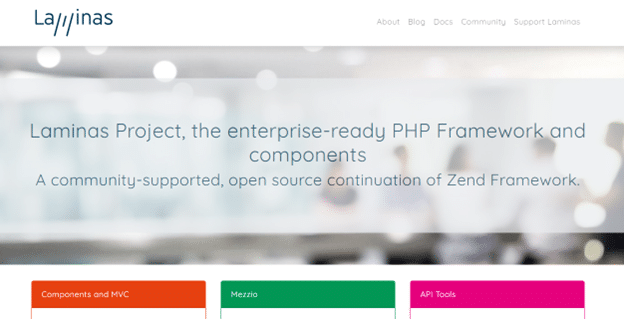
Credit: The Laminas Project
The Laminas Project is an open-source, enterprise-focused PHP framework and component library. Evolving from the renowned Zend Framework, which was integrated into the Linux Foundation in 2019, the Laminas Project carries forth its predecessor’s legacy. Crafted meticulously to assist developers in creating scalable, secure, and easily maintainable PHP applications, the Laminas Project envelops a plethora of features, from a robust MVC framework to efficient caching mechanisms.
What differentiates Laminas Project is its high adaptability. Developers can incorporate their bespoke features or meld the framework seamlessly with other third-party libraries, offering a platform that can evolve with changing requirements and innovations.
Why Use Laminas Project?
Deciding on the most apt framework can be a daunting task. Here’s what sets Laminas Project apart:
- Enterprise-Ready: Tailored specifically for enterprise applications, Laminas Project ensures security, scalability, and high performance.
- Adaptability: Laminas can be your go-to framework for crafting a straightforward website or a multifaceted e-commerce platform.
- Extendibility: The framework’s high extensibility allows for easily adding custom functionalities or amalgamation with third-party libraries.
- Thriving Community: With an active developer community behind it, many resources and support are available for the Laminas Project.
Advantages and Disadvantages
Considering the Laminas Project for your next big idea? Let’s weigh its strengths and limitations.
Advantages:
- Comprehensive Security Measures: Features like XSS protection, rigorous input validation, and secure session management ensure a fortified application.
- Scalability: Be it immense traffic or data handling, Laminas is built to manage without faltering.
- High Performance: The framework is optimized for rapid response times, even for intricate applications.
- Global Appeal: With built-in support for internationalization and localization, you can create applications catering to a global audience.
Disadvantages:
- Learning Curve: Laminas might come off as a tad complex for newcomers to PHP frameworks.
- Size: Being feature-rich also means the framework can be relatively larger than lightweight alternatives.
In a world where web development technologies evolve continuously, the Laminas Project establishes itself as a stalwart, offering an amalgamation of security, performance, and scalability. Ideal for those in quest of a comprehensive PHP framework, Laminas stands as a testament to progressive web application development.
14. Lumen
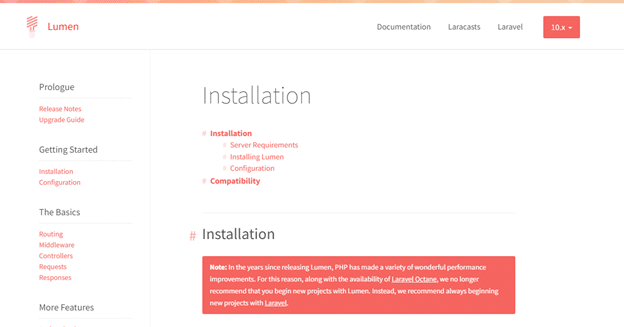
Credit: Lumen
Lumen is a powerful micro-framework crafted in PHP, specifically optimized for developing swift and efficient microservices and APIs. As an offspring of the renowned Laravel framework, Lumen retains the elegance and simplicity of its parent but with agility and minimalism tailored for lightweight applications. It is the perfect solution for developers eyeing rapid and resource-efficient development, especially in microservices or APIs.
While Laravel boasts a comprehensive suite of web application features, Lumen emphasizes speed and minimalism. Thus, it’s a preferred choice when the requirement revolves around high-performing APIs, backend services for applications, or fast-evolving microservices.
Why Use Lumen?
Lumen emerges as a formidable tool for a myriad of reasons:
Speed and Efficiency:
Tailored for performance, Lumen’s slim footprint ensures swift response times and efficient resource utilization, essential for microservices and APIs.
Ease of Adoption:
With a syntax and structure echoing Laravel, Lumen offers a gentle learning curve, especially to those acquainted with Laravel’s ecosystem.
Scalability:
Built to endure, Lumen gracefully scales with growing traffic, positioning it as a resilient choice for high-traffic microservices and APIs.
In-built Security:
Borrowing Laravel’s security practices, Lumen is fortified with protection against common vulnerabilities, including XSS, secure input validation, and robust session management.
Vibrant Community:
Riding on the coattails of Laravel, Lumen enjoys an enthusiastic community, ensuring a rich reservoir of resources, support, and packages.
Advantages and Disadvantages
Every framework exhibits its own strengths and weaknesses. Let’s dissect Lumen in this light.
Advantages:
- High Performance: Lumen’s design prioritizes speed, making it exceptionally fast for API and microservice development.
- Laravel Familiarity: Lumen’s similarity to Laravel facilitates a smoother transition for developers versed in the latter.
- Built-in Security Features: By incorporating Laravel’s security measures, Lumen ensures that applications are safeguarded against prevalent web threats.
- Strong Community Backup: Despite being lesser known than Laravel, Lumen still enjoys a supportive community, ensuring assistance when required.
Disadvantages:
- Feature Limitation: Being lightweight implies trade-offs. Lumen lacks some features in full-stack frameworks, possibly necessitating third-party libraries or custom code.
- Relative Obscurity: Lumen, being overshadowed by Laravel, might not be the first choice for many, making it harder to find Lumen-specific expertise.
- Sparse Documentation: Compared to more popular PHP frameworks, Lumen’s documentation is less extensive, which might pose hurdles for newcomers.
In conclusion, Lumen is a formidable choice for crafting microservices and APIs, especially when speed, efficiency, and scalability are paramount. However, a prospective Lumen developer should know the framework’s limitations and assess project requirements judiciously before diving in.
15. Flight
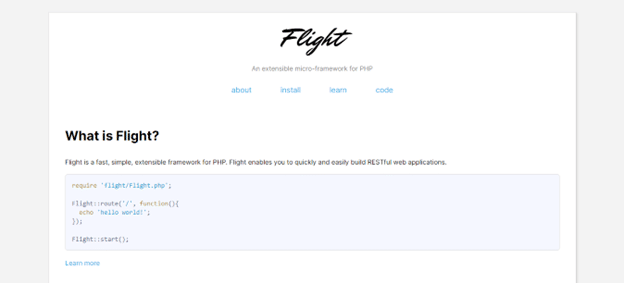
Credit: Flight
Flight is an extensible micro-framework crafted for PHP, laser-focused on facilitating developers to swiftly architect RESTful web applications. Unlike its heavyweight counterparts, such as Laravel and Symfony, Flight shines as a minimalist yet capable tool, emphasizing speed, simplicity, and flexibility.
Encompassing a straightforward approach to web application development, integrating Flight merely involves incorporating the framework and then mapping routes to respective callback functions. Despite its minimalistic demeanor, Flight doesn’t shy away from advanced features, boasting capabilities like dependency injection, middleware, and adept error handling.
Why Use Flight?
Dabbling into Flight is a decision motivated by several compelling reasons:
Speed & Efficiency:
Being a micro-framework, Flight’s compact nature ensures it’s blazing fast and optimized for high-octane web applications.
Simplicity at Heart:
With its intuitive API and clear structure, Flight ensures a smooth learning and development experience.
Customizable Core:
Flight’s architecture encourages adaptability. From middleware to routing, it’s built to cater to bespoke needs.
Resource-rich Ecosystem:
With exhaustive documentation and a burgeoning community, new adopters are never left in the lurch. Resources and assistance are always within arm’s reach.
Advantages and Disadvantages
In the grand spectrum of PHP frameworks, Flight has its own pros and cons.
Advantages:
- Lightning Fast: As a quintessential micro-framework, Flight’s nimbleness ensures top-tier performance.
- Beginner-Friendly: Its design emphasizes ease of use, ensuring even novices can get their applications up and running without a hitch.
- Highly Extensible: Flight’s architecture, coupled with features like middleware and dependency injection, ensures it can be molded as per specific needs.
- Robust Documentation & Community: With extensive documentation and a thriving community, support is always accessible.
Disadvantages:
- Feature Constraints: As a trade-off for its size and speed, Flight might not offer the extensive features that full-stack frameworks boast, such as in-built databases or authentication modules.
- Complexity Curve: While Flight excels in straightforward web apps, complexities might necessitate deeper dives into the nuances of PHP and general web development.
Flight is a frontrunner for those eyeing a lean, efficient, uncomplicated framework to whip up RESTful PHP web applications. However, it’s crucial to juxtapose the project’s requirements with Flight’s offerings to ensure a seamless development journey.
Choosing the Best PHP Framework
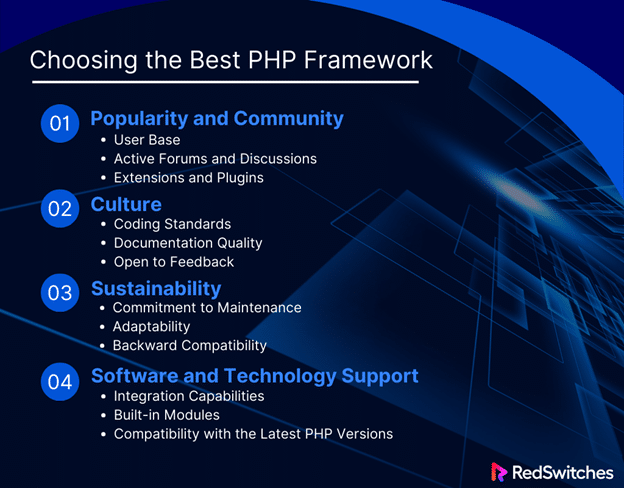
Selecting the right PHP framework for your project can feel like navigating a maze. While several high-quality options are available, each boasting its own features and advantages, how can you ensure you’re picking the best one for your specific needs? Let’s break down this decision-making process by looking into several key considerations.
1. Popularity and Community
A robust community around a framework can serve as a litmus test for its popularity and, by extension, its reliability.
- User Base: A popular framework often has a sizeable user base. This means many developers have tested it, encountered issues, and, more often than not, found solutions.
- Active Forums and Discussions: An active community can be a treasure trove of resources, including tutorials, FAQs, and best practices. Moreover, it’s reassuring to know that there’s help available if you hit a roadblock.
- Extensions and Plugins: A large community often results in various third-party plugins and extensions, facilitating smoother and faster development.
2. Culture
The culture of a framework can be an often overlooked yet crucial factor.
- Coding Standards: It’s beneficial if the framework adheres to the latest coding trends and best practices. This ensures code consistency, readability, and, often, better performance.
- Documentation Quality: A culture prioritizing comprehensive, updated, and precise documentation can significantly ease the learning curve and subsequent development processes.
- Open to Feedback: Frameworks that foster a culture of being receptive to feedback and continuous improvement tend to evolve and adapt better to the changing landscape of web development.
3. Sustainability
A framework’s longevity and adaptability over time is crucial, especially for projects that are meant to be long-term.
- Commitment to Maintenance: Ensure the framework is regularly updated, patched for security issues, and improved upon.
- Adaptability: A good framework should be modular, allowing it to adapt or integrate emerging technologies and methodologies.
- Backward Compatibility: While a framework needs to evolve, it’s equally crucial that updates don’t render older applications obsolete or introduce breaking changes frequently.
4. Software and Technology Support:
Ensuring the framework aligns well with the broader software ecosystem is fundamental.
- Integration Capabilities: The chosen framework should seamlessly integrate with other software, tools, or platforms you intend to use.
- Built-in Modules: It’s beneficial if the framework has built-in modules for frequently used functionalities such as authentication, caching, or database handling.
- Compatibility with the Latest PHP Versions: Ensure the framework supports or is on track to support, the latest versions of PHP. This can be crucial for security and performance.
Conclusion
Navigating the myriad of PHP frameworks can seem daunting, but equipped with the right knowledge, you can make the right decision that best aligns with your project’s requirements. Remember, a framework’s efficiency isn’t just about its in-built capabilities but how it pairs with complementary tools and services.
Ensuring a robust hosting environment is equally crucial for complementing your framework choice. This is where RedSwitches steps in. As a leading hosting company, RedSwitches not only guarantees optimal uptime but also ensures that your PHP applications run smoothly, efficiently, and securely. Pairing your PHP framework with RedSwitches‘ superior hosting capabilities can elevate your application’s performance, security, and user experience.
If you’re looking for a hosting solution that aligns perfectly with your chosen PHP framework, look no further. Dive into the unparalleled services of Red Switches and watch your web application soar to its full potential. Explore RedSwitches Now!
FAQs
What is PHP frameworks?
PHP frameworks provide a structured and efficient way to develop web applications by offering reusable code modules, established MVC architecture, and best practices.
What is the best PHP framework for beginners?
Laravel is often recommended for beginners due to its user-friendly syntax, extensive documentation, and active community support.
Which PHP framework to choose?
The choice of a PHP framework depends on project requirements, familiarity with the framework, scalability needs, and the kind of support and documentation you desire. Popular choices include Laravel, Symfony, and CodeIgniter.
Is PHP a web application framework?
No, PHP is a server-side scripting language. However, numerous PHP-based web application frameworks exist, such as Laravel, Symfony, and CodeIgniter.
What is PHP used for?
PHP is used primarily for developing dynamic web applications. It facilitates data integration and session management and can be embedded directly into HTML.
Why should I use PHP frameworks?
PHP frameworks provide a structured way to build web applications, making development faster and more efficient. They offer reusable components, better security, and help adhere to best practices and design patterns.
What are the benefits of using PHP frameworks?
Using PHP frameworks can help improve development time, provide better code organization, enhance security measures, and offer a range of built-in features and tools.
Can you recommend some popular PHP frameworks?
Some popular PHP frameworks include Laravel, Symfony, CodeIgniter, CakePHP, Yii, and Zend Framework.
What should I look for in a PHP framework?
When choosing a PHP framework, consider factors such as ease of use, community support, documentation, performance, scalability, built-in features, and compatibility with your specific project requirements.
What are the 10 best PHP frameworks?
The 10 best PHP frameworks for web development in 2023 are Laravel, Symfony, CodeIgniter, CakePHP, Yii, Zend Framework, Phalcon, FuelPHP, Slim, and Aura.
Which PHP framework is the best for web development?
The right PHP framework for web development depends on your specific needs and preferences. Popular choices include Laravel, Symfony, and CodeIgniter.
What is a PHP MVC framework?
A PHP MVC framework follows the Model-View-Controller architectural pattern, which separates the application logic into three different components: the model, which handles data management; the view, which handles data presentation; and the controller, which handles user input and application flow.
Can you recommend a lightweight PHP framework?
CodeIgniter is a lightweight PHP framework that is often favored for its simplicity and speed.
Which PHP frameworks should I use in 2024?
The best PHP frameworks to use in 2024 include Laravel, Symfony, CodeIgniter, CakePHP, and Yii.
